
Old town hall Bremen
The market square is the historical heart of the city, around the square you will find the most famous sights of Bremen. The Bremen town hall is the most magnificent building on the market and is a UNESCO World Heritage Site.
The town hall consists of an old town hall and a new town hall. The old town hall (photo) stands on the north side of the market square, behind which the new town hall was built. The old town hall was built in 1410 in the Gothic style. It replaced an older building nearby. With this town hall, the citizens of Bremen set a self-confident signal in the direction of the archbishop. The citizens of Bremen had their civil rights confirmed by the archbishop in a document in 1139 and in 1365 they introduced the citizen oath. Only those who took the citizen's oath could take on an office in Bremen.
The Gothic town hall didn't look like it does today. The facade was redesigned in the Flemish style during the Renaissance. The middle section with the high gable was designed in 1608 by Lüder von Bentheim, who had previously rebuilt the town hall in Leiden (Netherlands). The arcades with the round arches on the ground floor, date from the Gothic period. The interior, which is well worth seeing, with the large hall on the upper floor, was also built in the first construction phase. The facade figures adorned the Gothic building. The 8 figures show the emperor and the 7 electors.
The new building was designed in 1904 by Gabriel von Seidl in the neo-renaissance style so that it fits in with the old town hall. Bremen's town hall survived the bombing raids of World War II unscathed and is therefore one of the most important buildings in the city.
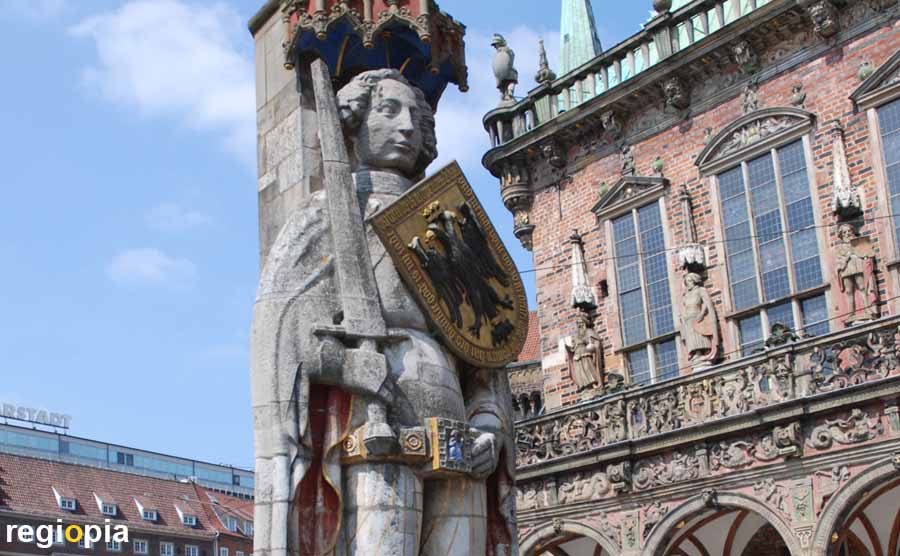
Bremen Roland
The Roland is the landmark of Bremen, he stands in front of the old town hall. It is the stone testimony to the privileges that the emperor granted the citizens of Bremen. The Roland is proclaiming market rights and civil liberty since 1366. The people of Bremen fought for these rights against the archbishop. The sandstone figure is the symbol of Bremen's freedom. As long as the Roland stands, Bremen is a free city. Today Bremen is a separate federal state with around 650,000 inhabitants. By far the smallest federal state is hardly viable and heavily in debt, but freedom is important to the people of Bremen.
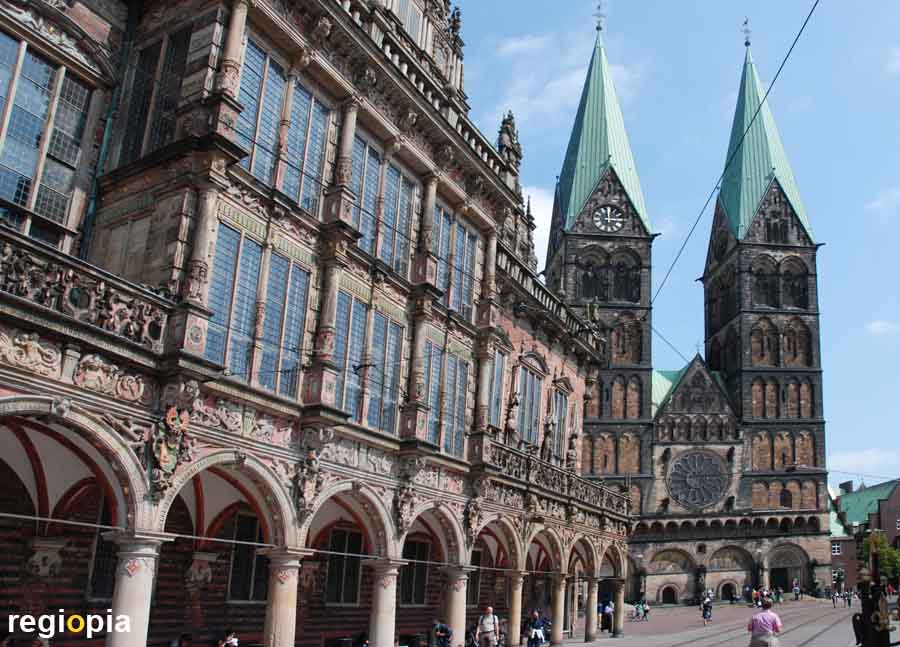
Bremen Cathedral
The St Petri Dom in Bremen was built at the highest point in the city center. Churches are said to have stood here since 789 AD. The great fire of 1041 destroyed the whole city and the church had to be completely rebuilt. The new cathedral was started in the Romanesque style and was completed in the Gothic style. On the facade you can see predominantly Romanesque arches. The northern tower was completed in 1346. The southern tower collapsed in 1638 and was not rebuilt until 1901. Despite the extensive redesign of the west facade from 1888, the Bremen Cathedral looks neither elegant nor well-proportioned. The twin towers of St. Petri rise around 90 m into the sky, making them the tallest towers in the old town of Bremen. If you want to see Bremen from above, you can climb the south tower.
The interior is beautiful, slim columns and Gothic vaulted ceilings convey a harmonious impression. Nevertheless, one can still read off the Romanesque origins of the church. The thick walls and the windows, which are far too small for a Gothic cathedral, leave no room for doubt.
From 1224 St. Petri was the main church of the archbishop. Bremen Cathedral has been a Protestant church since the Reformation. The cathedral was hardly damaged in the Second World War.
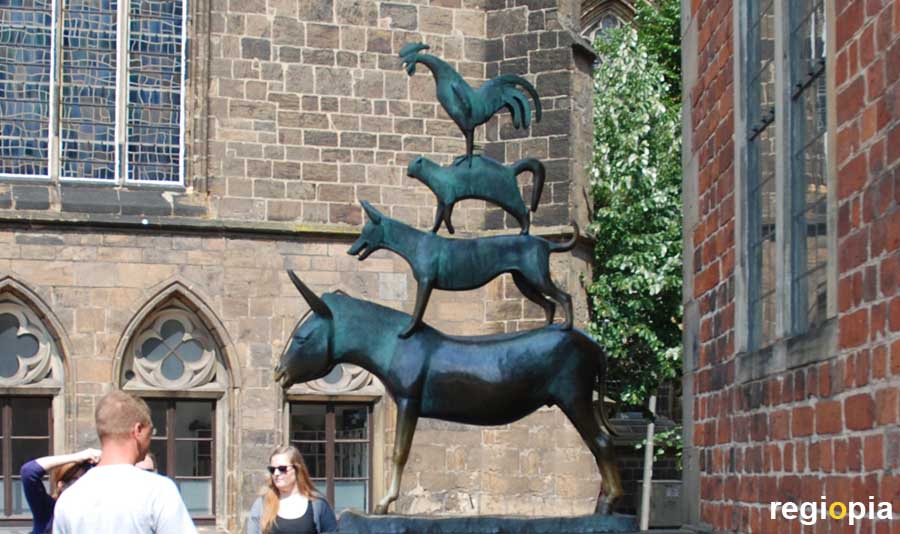
Bremen Town Musicians
The Bremen Town Musicians are a sculpture by Gerhard Marcks at the Town Hall. The animals standing on top of each other go back to a fairy tale by the Brothers Grimm. It shows a donkey, a dog, a cat and a rooster who team up to become the Bremen Town Musicians. On the way to Bremen they look for a place to stay for the night and come across a band of robbers who live in a house. They drive away the robbers with their screams and stay in the house. They never went on to Bremen.
The bronze sculpture was erected in 1953 and has since developed into a landmark of Bremen. If you touch both hooves of the donkey at the same time, it is said to bring good luck. Today it brings Corona, so dear children, don't forget to wash your hands.
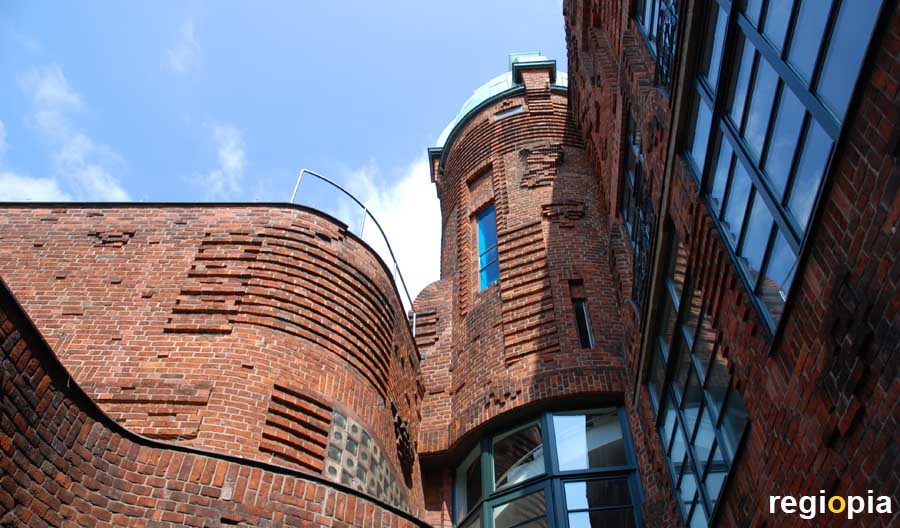
Boettcher Street
Barrels (german Bottiche) used to be made in Böttcherstrasse. Most of the buildings on the narrow alley, however, were not erected until 1922-31. Bremen owes the wonderful brick architecture to the rich coffee roaster Ludwig Roselius, who commissioned the buildings.
Roselius commissioned the architects Eduard Scotland, Alfred Runge, Carl Eeg and the sculptor Bernhard Hoetger to design the Böttcherstrasse. The result is a work of art made up of expressionist architecture and sculpture that is well worth seeing. If you go south from the market square you can see the relief "Der Lichtbringer" (the bringer of light) by Hoetger. The golden image shows the Archangel Michael slaying the dragon. Saint Michael is considered the protector of Germany. A symbolism that was then attributed to the Führer by the National Socialists. The founder Roselius was not averse to a Germanic way of thinking, but the choice of his architects and artists shows a more modern understanding of art.
Böttcherstraße is now a tourist attraction with shops, handicrafts and the Paula Modersohn-Becker Museum. An expressionist female painter from the Worpswede artists' colony.
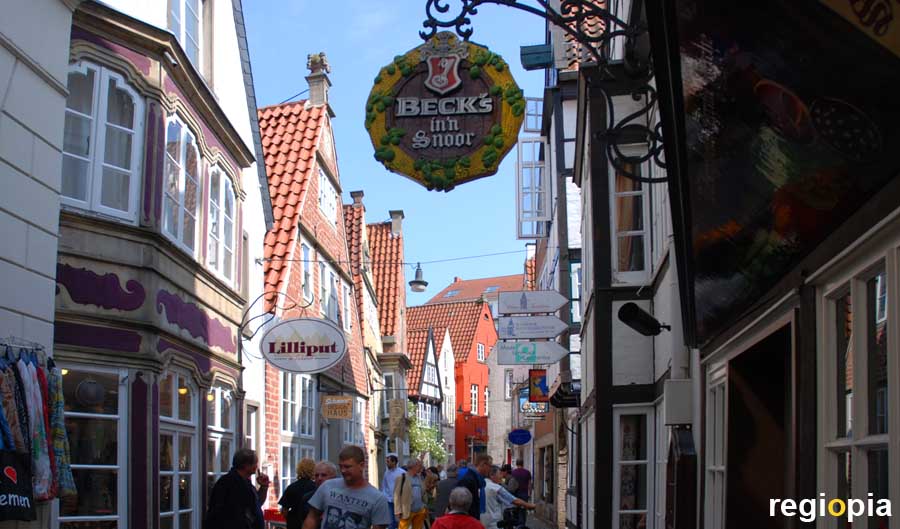
Schnoor
The Schnoor is an idyllic district with narrow streets and cute houses. The quarter is the oldest part of Bremen and is still very reminiscent of a small fishing village on the river. The name "Schnoor" means cord and is also the main street of the district. In the "Schnoor" there are houses like from a picture book, small and cute with a gable roof made of red roof tiles. Whether plastered, with a brick facade or as a half-timbered house, the houses enchant every visitor. There are small shops, cafes and restaurants on the ground floor. The side streets and inner courtyards are also worth seeing.
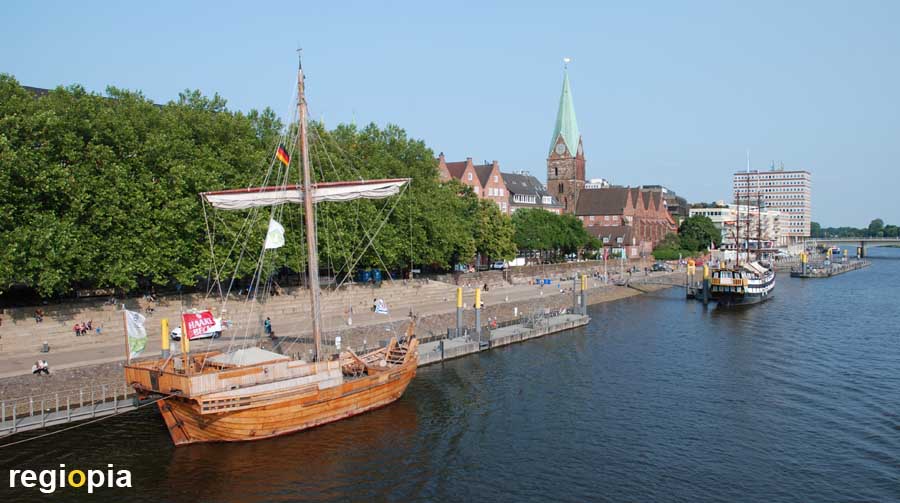
Schlachte
The Schlachte is the promenade on the Weser, where the port of Bremen was located in the Middle Ages. Hanseatic cogs brought goods from all Hanseatic cities to Bremen. Life pulsed here until the Weser was too shallow for the big ships. The name Schlachte is derived from stakes that were rammed into the ground to secure the river bank.
Today the Schlachte is a nightlife mile with many restaurants and bars. When the weather is nice, you can sit behind the sea wall, under tall trees and look out over the Weser. Due to the south-west orientation of the promenade, the sun shines here for a long time in summer. The many beer gardens create a southern German nonchalance that doesn't need to hide behind Munich. Ships worth seeing are tied up on the quay, some of which are used as an event location or as a restaurant ship. Most of the restaurants are located between the St. Martini Church and the Bürgermeister Schmidt Bridge.
ads
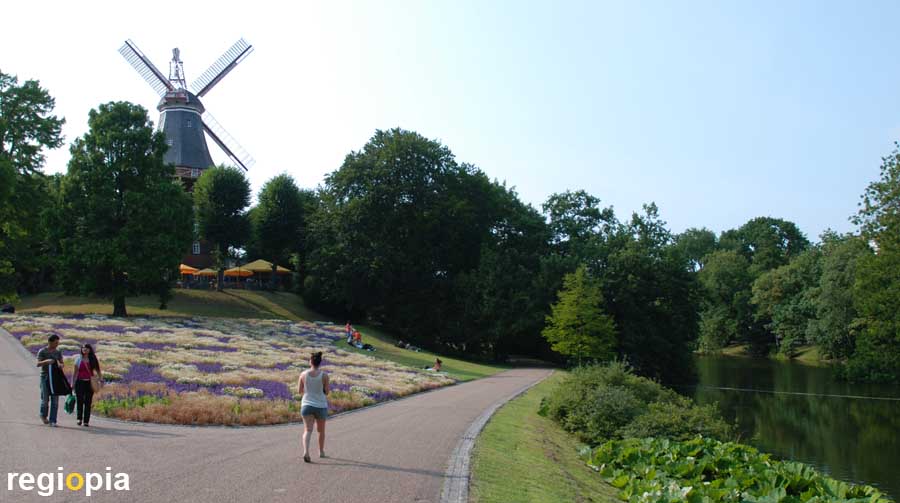
Mühle am Wall
The Mühle am Wall (Mill at the Wall) is a Bremen landmark that is now located in a park that was laid out on the former city fortifications. The Bremen city wall was built from 1229 and was continuously expanded until 1664. From 1803 the city wall had lost its military use and was demolished. The fortress became a public park and the moats became ponds. From the air you can still see the jagged bastions. Mills were built on the hills, one of which is still preserved. Today there is a café in the Mill at the Wall.
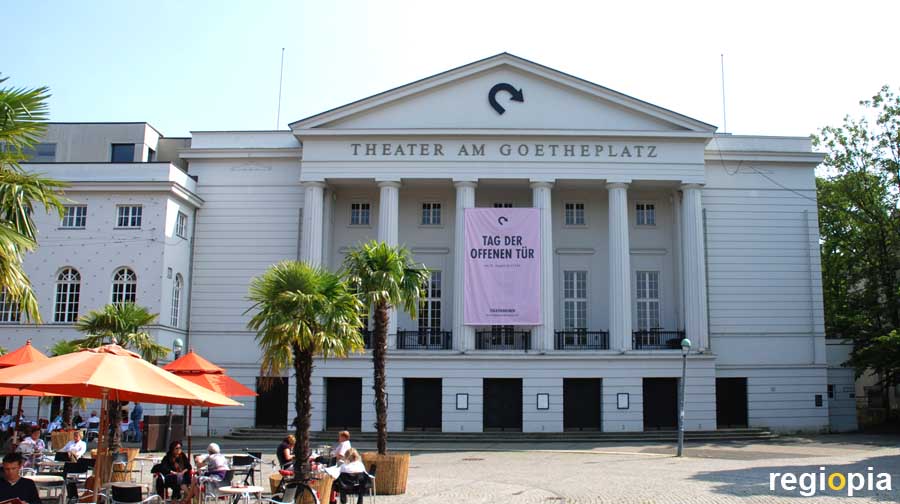
Bremen Theater
The Bremen Theater is located at the Ostertor, very close to the Kunsthalle Bremen. Towards Goetheplatz (photo) the theater has a classical facade with a gable and Doric columns. The Bremen Theater consists of the "Theater am Goetheplatz" and the New Playhouse in the "Small House" behind it. The brewery cellar, Villa Ichon and MoKS are also located on the property. The cultural heart of the Hanseatic city beats around Goetheplatz. If you would like to find out more about events you can find more information, see link below.
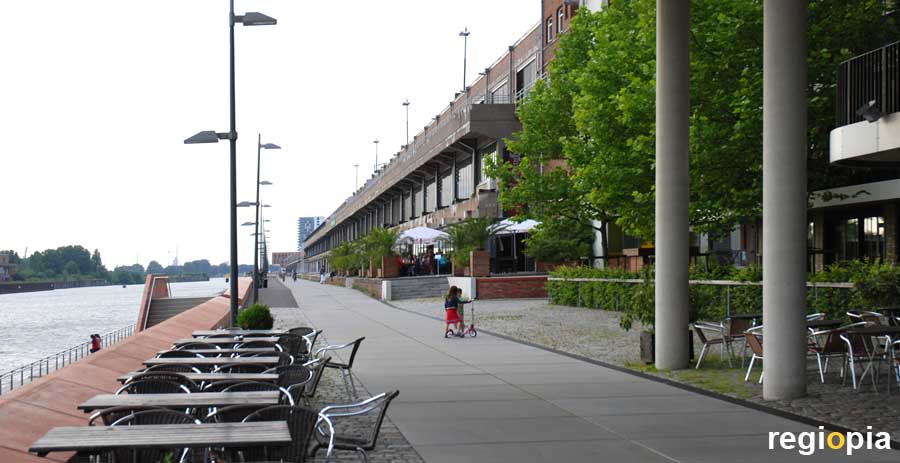
Überseestadt Bremen
The Überseestadt Bremen is a new district that is currently being built on the land of the old port facilities. The master plan to transform the port into a modern residential and office district has been implemented in 2000. A lot has been built, but there are still large wastelands where weeds are growing rampant. The Überseestadt cannot yet be described as a top attraction, but the constant change makes the district quite interesting. There are old warehouses in which cultural establishments and restaurants have settled. When the weather is nice, the cafés on the quayside are well attended. With the Weser Tower by Helmut Jahn, the tallest office building in Bremen with a height of 82 m has stood here since 2010. For more information on Überseestadt, events, restaurants and guided tours, see the link.
How to get there
Take tram line 3 from the city center in the direction of Gröpelingen to the BremenEuropahafen stop.
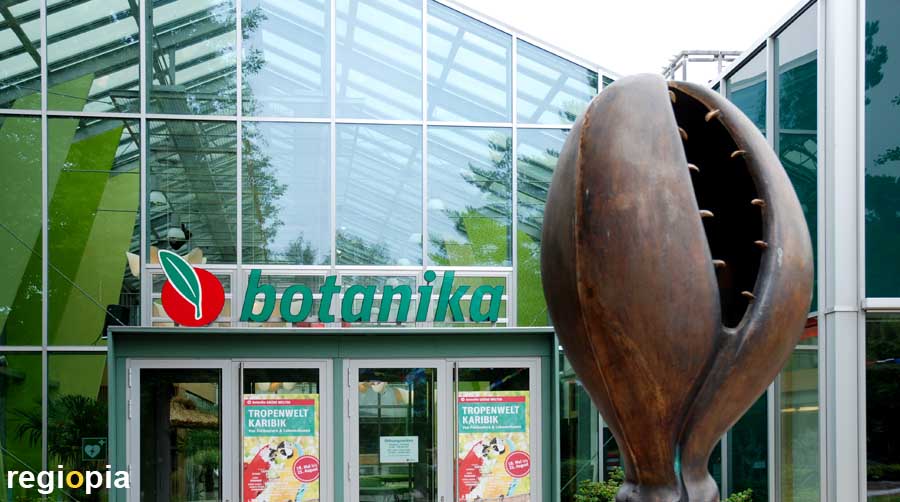
Botanical Garden and Rhododendron Park
The Bremen Botanical Garden is located in the Rhododendron Park in the Horn district. In the north of the park is the Botanika, an adventure world made up of four greenhouses in which you can discover plants from different continents. In the middle of the park is the Botanical Garden, which was relocated to this location in 1950. In the far south is the part where rhododendrons and azaleas grow. In the far north is the scented garden with lots of flowers and a rose garden. If you get hungry after the tour of the 46 hectare site, there is a restaurant at the Botanika.
How to get there
The main entrance is on Marcusallee. Bus 31 to the Rhododendron Park stop. Visitor parking spaces are located at Deliusweg 44.
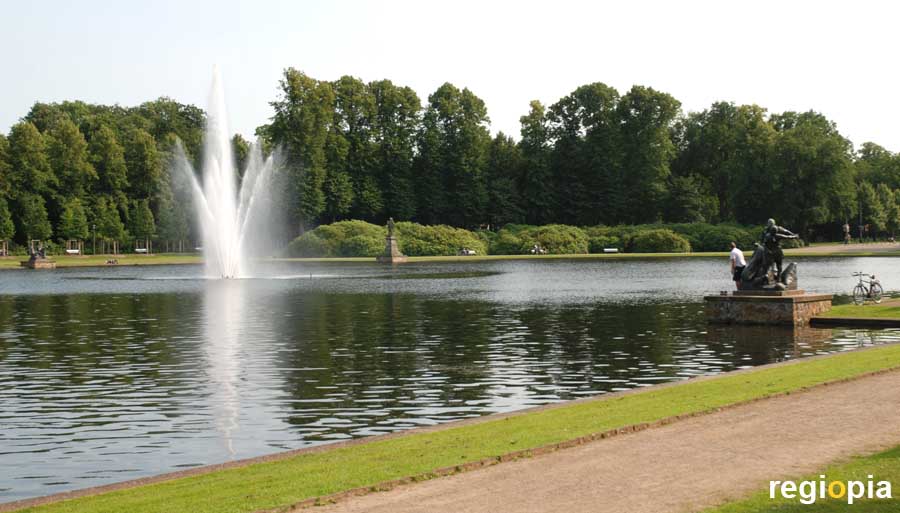
Bürgerpark Bremen
The Bürgerpark is Bremen's Central Park. It is located north of the central station and extends as far as the city forest. In the southern part is the Holler See, designed in the Baroque style, with sculptures and a large fountain. The Parkhotel spreads out like a castle on the north side of the lake. An English landscape park with large meadows and isolated groups of trees begins behind the hotel. At the lake Emmasee you will find a modernist coffee house by the water. A little more elegant is the Restaurant Meierei in the Bürgerpark with an inner courtyard that opens onto the lake.
The Bürgerpark emerged from a citizens' initiative by Johann Hermann Holler, which began to redesign the site in 1866. The Bürgerpark was designed by garden architect Wilhelm Benque, who studied parks and gardens in New York. With 170 workers, Benque set to work to realize his plan. The first thing to do was the artificially created Emmasee. The Bürgerpark was completed in 1886.
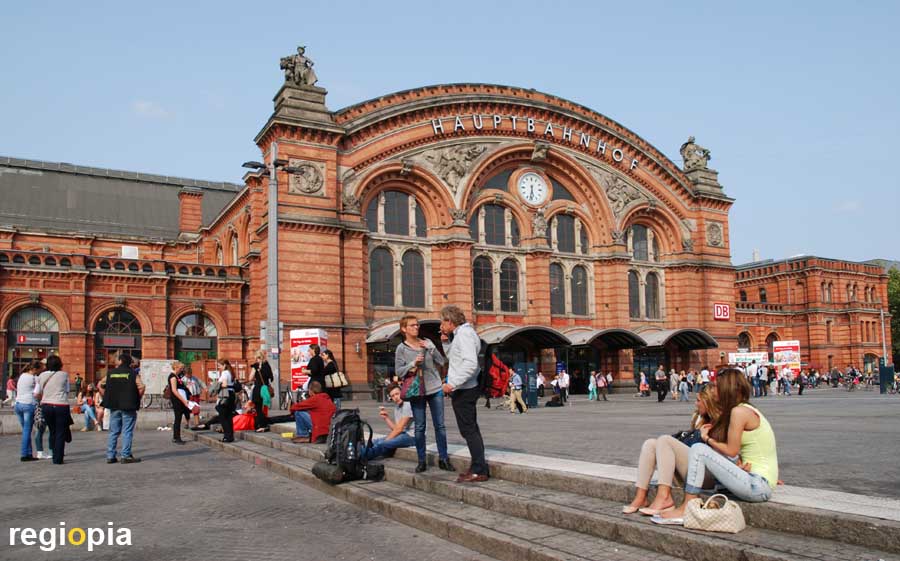
Bremen Central Station
The Bremen central station is one of the most beautiful train stations in Germany. The architect Hubert Stier had previously designed the Hanover Central Station. Bremen Central Station was opened in 1889. The through station has 7 tracks in the hall and two outside. The south facade towards the center is designed in the neo-renaissance style. Red bricks and sandstone reliefs decorate the facade. The reliefs show shipping, railway, the imperial eagle and the coats of arms of the cities of Cologne, Hamburg, Hanover and of course Bremen.
Map Bremen attractions
ads
Travel Guide Bremen
ads
ads


